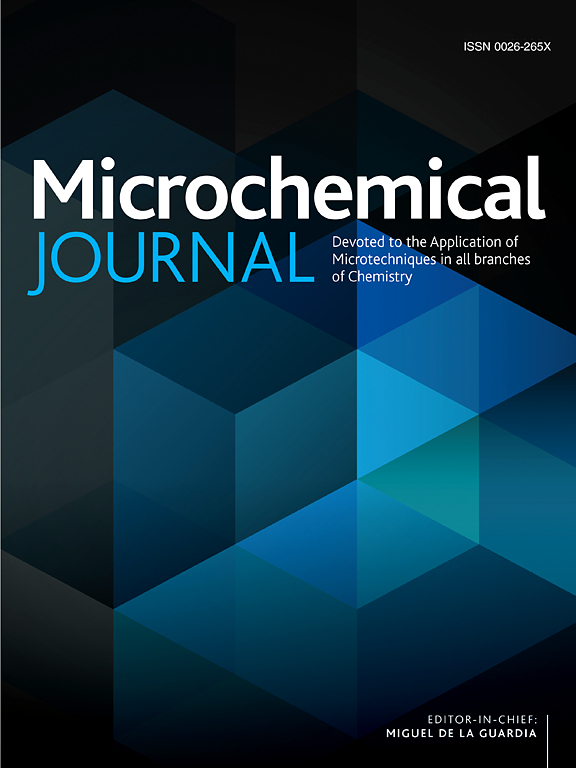具有表面增强拉曼散射/上转换发光/磁共振特性的复杂Yb/Er共掺杂NaGdF4@Au纳米复合材料介导的阿尔茨海默病生物标志物的三模式传感
IF 4.9
2区 化学
Q1 CHEMISTRY, ANALYTICAL
引用次数: 0
摘要
基于多用途光学纳米复合材料的多模态传感技术迅速发展,使生物物质的快速、精确诊断具有高灵敏度和高分辨率。在本研究中,Yb/Er共掺杂NaGdF4@Au纳米复合材料采用表面改性促进的高效静电吸引策略合成。敏化钇离子的数量和金纳米粒子(NPs)的掺入是影响上转换发光的关键因素。值得注意的是,gd参与的纳米复合材料证明了浓度依赖的磁共振成像(MRI),允许脑神经瘤细胞的双模式生物成像。由于组装在NaGdF4基体上的Au纳米粒子产生了增强的局域电磁场,进一步从纳米复合材料中获得了表面增强拉曼散射(SERS),表现出可靠的灵敏度、再现性、均匀性和稳定性。因此,基于SERS模式建立的线性剂量响应曲线,将所提出的纳米复合材料用于淀粉样蛋白- β 42的典型三明治免疫分析。这种多模态传感平台对多种临床生物医学诊断具有重大潜力。本文章由计算机程序翻译,如有差异,请以英文原文为准。
Tri-mode sensing of Alzheimer’s disease biomarkers mediated by sophisticated Yb/Er co-doped NaGdF4@Au nanocomposites with surface enhanced Raman scattering/up-conversion luminescence/magnetic resonance properties
Multi-modal sensing techniques based on versatile optical nanocomposites have advanced rapidly, enabling fast and precise diagnosis of biological substances with high sensitivity and resolution. In this study, Yb/Er co-doped NaGdF4@Au nanocomposites were synthesized using an efficient electrostatic attraction strategy facilitated by surface modification. The quantity of sensitizing Yb ions and the incorporation of Au nanoparticles (NPs) were identified as crucial factors influencing upconversion luminescence (UCL). Notably, concentration-dependent magnetic resonance imaging (MRI) was demonstrated for the Gd-participated nanocomposites, allowing for dual-mode bioimaging of brain neuroma cells. Attributed to the enhanced localized electromagnetic field generated by the Au NPs assembled on the NaGdF4 matrix, surface enhanced Raman scattering (SERS) were further obtained from the nanocomposites, which demonstrated reliable sensitivity, reproducibility, homogeneity, and stability. Consequently, the proposed nanocomposites were employed in a typical sandwich immunoassay for Amyloid-beta 42, based on a linear dose–response curve established through SERS modality. This multi-modal sensing platform holds significant potential for diverse clinical biomedical diagnostics.
求助全文
通过发布文献求助,成功后即可免费获取论文全文。
去求助
来源期刊

Microchemical Journal
化学-分析化学
CiteScore
8.70
自引率
8.30%
发文量
1131
审稿时长
1.9 months
期刊介绍:
The Microchemical Journal is a peer reviewed journal devoted to all aspects and phases of analytical chemistry and chemical analysis. The Microchemical Journal publishes articles which are at the forefront of modern analytical chemistry and cover innovations in the techniques to the finest possible limits. This includes fundamental aspects, instrumentation, new developments, innovative and novel methods and applications including environmental and clinical field.
Traditional classical analytical methods such as spectrophotometry and titrimetry as well as established instrumentation methods such as flame and graphite furnace atomic absorption spectrometry, gas chromatography, and modified glassy or carbon electrode electrochemical methods will be considered, provided they show significant improvements and novelty compared to the established methods.
 求助内容:
求助内容: 应助结果提醒方式:
应助结果提醒方式:


